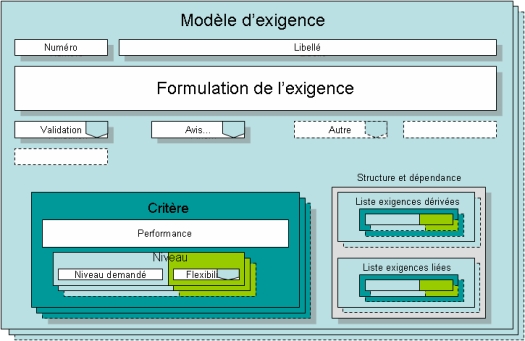
|
Solution: Envision Requirements |
|
Requirements engineering insure that product design meet users expectation
and product's specification along the product's cycle life, with no
ambiguity, while tracking the necessary evolutions
|
 Requirements management with E.U. norms NF X50-150-151 Requirements management with E.U. norms NF X50-150-151
Management
of requirements and their evolutions during a product, system or service
life cycle, makes it possible to deliver solutions in conformity with the user
expectations, within the time limits and removes many problems: Fuzzy or
ambiguous requirements, not exploitable schedule of conditions, lake of
visibility, uncontrolled changes, unknown project status and impact analysis
impossible to carry out. Requirements analysis and management strongly
contribute to increase product quality.

Various ways of using requirements management within Envision
Autonomous with Envision Requirements: for stand alone requirements management
With
Envision Systems Engineering
Integrated in the system engineering process (includes Envision Analyst)
With
Envision
Analyst Integrated in a general functional analysis tool
With
Envision
UML
Integrated with an object oriented UML design tool (CASE)
With
Envision
SART-SD
Integrated with an analysis and design tool for real time applications (CASE)
|
Requirements engineering process
En vision
Requirements TM
will enable you to create your own requirements management process,
tailored to your needs.
You graphically build your
requirements management process starting from the meta model. It can includes:
Phases - Stakes - Folders - Requirements status and documents expertise
status. Of course you can add your own.!
-
Record and track the evolutions of each
requirement
-
Check the impact of the modifications
on the derived and linked requirements
-
Automatically inform
by e-mail all personnel concerned by the changes
En vision
ensures traceability with all the elements contained in the repository.
see
requirements details
See also a complementary solution
Envision SADT-Idef0
|
|
Information and prices 
|
Consulting and services
-
Functional analysis sessions management (on site)
- Specification document design
and production
- Technology
transfer
- Integration
of existing data
|
|
Solution key points
-
Visual requirements management and follow-up
offer a great facility for use and re-use - Training is 1/2 day
-
Flexible and fully
customizable, it takes into count company history and trades, which
facilitates its deployment in an environment of practices and of existing
tools
-
The centralized data base
guaranteed an available, reliable and up-to-date project's information
-
Historic of changes and
versioning manage the necessary evolutionarily of projects
-
Traceability helps to understand changes
impact and reduces risks and conflicts
-
Powerful, it manages thousands of linked
requirements with ergonomic facilities, fast navigation, versatile
analysis and search tools
-
Work group sharing
information in real time (Work group) improves team communication and help
integration of the newcomers
-
The automatic generation of reports to the company
formats brings dramatic time saving and increases users added value
-
The re-use of information develops and capitalizes the analysis effort.
|
Information leveraging solutions
tailored to each enterprise and its projects.
In France since 1989
 |
|
Structure of a requirement |
|
The
implemented "meta model" technology makes it possible to create your own
requirement template in order to fit a specific need. All informative,
functional and visual attributes are customizable. |
|
 |
|
A
requirement is defined by (E.U. standard AF X50-150-151):
-
User's defined data entry fields (N° - Label - Formulation - Status…)
-
One
or more criteria, each one defined by a performance
-
Each
performance is evaluated by one or more awaited levels
-
Each
awaited level contains a definition and a flexibility, e.g.: F0 - Mandatory,
F1 - Negotiable…
|
|
|
|
Requirement characterization |
|
Genesis
Edit or simply import your requirements coming from various sources:
functional analysis document - manual - Word - Excel…
Characterization
The
characterization consists in defining the performance of one or more criteria
and for each one of them, to specify one or more awaited levels. A flexibility
is associated to each awaited level: F0 - mandatory, F1 - negotiable etc. E.U.
standard NF X50-150
Deriving requirement
Naturally derive the design requirements starting from the functional
analysis document. Envision
requirements
automatically maintains the original links
Dependency link
Specify the dependency
links between requirements (dependent requirements) in order to later trace
the impact of a modification on the fulfillment of other related
requirements.
|
|
|
|
Open
issues follow-up |
|
You create “open issues” at the time of difficulties, in the definition or
in the implementation of a
requirement.
An
open issue is characterized with the following basic attributes:
|
-
Author
-
Followed by
-
Dates: opening -
target - closing
-
Tasks
|
|
|
|
|
Experience feedbacks management |
|
Management of project's experience feedbacks means capitalization and
valorization of the critical information in your engineering process. It is
the history of the company's knowledge and is an essential element for
the search for quality improvement.
Envision
Requirements
allows the recording and the research of experience feedbacks comment in the
project's data base for requirements, criteria and levels, with the
following domain fields:
-
Technical
-
Specification
-
Project
-
Others...
A specific inter
projects feedbacks data base allows consolidation of all experience
feedbacks through all projects. Research is done by key words and filters
and the results are displayed in tables “à la Excel”. |
|
|
|

